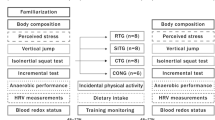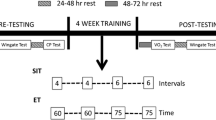Abstract
Purpose
The primary objective of the study was to compare the implications of body composition on work volume, power outputs (peak, mean, and minimum), and relative drop load throughout 4 weeks of sprint interval training (SIT) in individuals living with and without obesity.
Methods
Thirty-four participants living with (n = 16) and without (n = 18) obesity took part in 12 sessions of SIT over 4 weeks. SIT consisted of repeated 30-s Wingate with a drop load of 7.5% of the participant’s body mass separated by 4 min of active recovery. Fat-free mass was estimated using a BOD POD. Work volume, drop load, and power output (peak, mean, and minimum) relative to body mass and fat-free mass were calculated using a Monark 874E Weight cycle ergometer.
Results
Individuals living with obesity had a significantly larger drop load relative to fat-free mass (p < 0.001) and absolute drop load (p < 0.001) as well as a lower cycling cadence (p < 0.001) compared to individuals without obesity. No significant difference was observed in work volume (p = 0.167) as well as mean (p = 0.903), peak (p = 0.294), and minimum (p = 0.103) power relative to fat-free mass between groups.
Conclusion
The findings suggest that individuals living with obesity work at a higher relative drop load when utilizing a percentage of body mass; however, a reduced cycling cadence results in similar total work volume throughout SIT.





Similar content being viewed by others
Availability of data and material
The datasets analyzed during the current study are available from the corresponding author on reasonable request.
Code availability
Not applicable.
Abbreviations
- ANOVA:
-
Analysis of variance
- BMI:
-
Body mass index
- CSEP:
-
Canadian society for exercise physiology
- KGM:
-
Kilogram-meters
- RPM:
-
Revolutions per minute
- SIT:
-
Sprint interval training
- W/kg:
-
Watts per kilogram
References
Baker J, Davies B (2003) Resistive force selection during brief cycle ergometer exercise: power profiles of rugby union players. Med Sci Sport Exerc. https://doi.org/10.1097/00005768-200305001-01873
Baker JS, Davies B (2006a) Brief high-intensity exercise and resistive force selection in overweight and obese subjects: body mass or body composition? Res Sports Med (print) 14(2):97–106. https://doi.org/10.1080/15438620600651298
Baker JS, Davies B (2006b) Variation in resistive force selection during brief high intensity cycle ergometry: implications for power assessment and production in elite karate practitioners. J Sports ScieMed 5(CSSI):42–46
Baker JS, Bailey DM, Davies B (2001) The relationship between total-body mass, fat-free mass and cycle ergometry power components during 20 seconds of maximal exercise. J Sci Med Sport 4(1):1–9. https://doi.org/10.1016/s1440-2440(01)80002-5
Baker JS, Bailey DM, Hullin D, Young I, Davies B (2004) Metabolic implications of resistive force selection for oxidative stress and markers of muscle damage during 30 s of high-intensity exercise. Eur J Appl Physiol 92(3):321–327. https://doi.org/10.1007/s00421-004-1090-9
Baker JS, Graham MR, Davies B (2007a) Metabolic consequences of resistive force selection during cycle ergometry exercise. Res Sports Med 15(1):1–11. https://doi.org/10.1080/15438620600985928
Baker JS, Van Praagh E, Gelsei M, Thomas M, Davies B (2007b) High-intensity intermittent cycle ergometer exercise: effect of recovery duration and resistive force selection on performance. Res Sports Med (print) 15(2):77–92. https://doi.org/10.1080/15438620601184190
Bar-Or O (1987) The wingate anaerobic test. An update on methodology, reliability and validity. Sports Med (auckland, NZ) 4(6):381–394. https://doi.org/10.2165/00007256-198704060-00001
Burgomaster KA, Hughes SC, Heigenhauser GJF, Bradwell SN, Gibala MJ (2005) Six sessions of sprint interval training increases muscle oxidative potential and cycle endurance capacity in humans. J Appl Physiol (bethesda, Md.: 1985) 98(6):1985–1990. https://doi.org/10.1152/japplphysiol.01095.2004
Burgomaster KA, Heigenhauser GJF, Gibala MJ (2006) Effect of short-term sprint interval training on human skeletal muscle carbohydrate metabolism during exercise and time-trial performance. J Appl Physiol (bethesda, Md.: 1985) 100(6):2041–2047. https://doi.org/10.1152/japplphysiol.01220.2005
Cocks M, Shaw CS, Shepherd SO, Fisher JP, Ranasinghe A, Barker TA, Wagenmakers AJM (2016) sprint interval and moderate-intensity continuous training have equal benefits on aerobic capacity, insulin sensitivity, muscle capillarisation and endothelial ENOS/NAD(P)Hoxidase protein ratio in obese men. J Physiol 594(8):2307–2321. https://doi.org/10.1113/jphysiol.2014.285254
Colpitts BH, Seaman K, Eadie AL, Brunt KR, Bouchard DR, Sénéchal M (2021) Effects of sprint interval training on substrate oxidation in adults living with and without obesity: the i-FLEX Study. Physiol Rep 9(11):e14916. https://doi.org/10.14814/phy2.14916
CSEP (2017) Canadian society for exercise physiology—physical activity training for health resource manual. CSEP
Duché P, Ducher G, Lazzer S, Doré E, Tailhardat M, Bedu M (2002) Peak power in obese and nonobese adolescents: effects of gender and braking force. Med Sci Sports Exerc 34(12):2072–2078. https://doi.org/10.1097/00005768-200212000-00031
Gist N, Fedewa MV, Dishman RK, Cureton KJ (2014) Sprint interval training effects on aerobic capacity: a systematic review and meta-analysis. Sports Med (auckland, NZ) 44(2):269–279. https://doi.org/10.1007/s40279-013-0115-0
Marshall SJ, Nicaise V, Ji M, Huerta C, Haubenstricker J, Levy SS, Ainsworth B, Elder JE (2013) Using step cadence goals to increase moderate-to-vigorous-intensity physical activity. Med Sci Sports Exerc 45(3):592–602. https://doi.org/10.1249/MSS.0b013e318277a586
Nie J, Kong Z, Baker JS, Tong TK, Lei SH, Shi Q (2012) Acute changes in glycemic homeostasis in response to brief high-intensity intermittent exercise in obese adults. J Exerc Sci Fit 10(2):97–100. https://doi.org/10.1016/j.jesf.2012.10.007
Reljic D, Lampe D, Wolf F, Zopf Y, Herrmann HJ, Fischer J (2019) Prevalence and predictors of dropout from high-intensity interval training in sedentary individuals: a meta-analysis. Scand J Med Sci Sports. https://doi.org/10.1111/sms.13452
Retallick CJ, Baker JS, Williams SR, Whitcombe D, Davies B (2007) Plasma volume response to 30-s cycle ergometry: influence on lipid and lipoprotein. Med Sci Sports Exerc 39(9):1579–1586. https://doi.org/10.1249/mss.0b013e318093f585
Rowley TW, Espinoza JL, Akers JD, Wenos DL, Edwards ES (2017) Effects of run sprint interval training on healthy, inactive, overweight/obese women: a pilot study. FACETS. https://doi.org/10.1139/facets-2016-0004
Thorogood A, Mottillo S, Shimony A, Filion KB, Joseph L, Genest J, Pilote L, Poirier P, Schiffrin EL, Eisenberg MJ (2011) Isolated aerobic exercise and weight loss: a systematic review and meta-analysis of randomized controlled trials. Am J Med 124(8):747–755. https://doi.org/10.1016/j.amjmed.2011.02.037
Tong TK, Zhang H, Shi H, Liu Y, Ai J, Nie J, Kong Z (2018) Comparing Time efficiency of sprint vs. high-intensity interval training in reducing abdominal visceral fat in obese young women: a randomized, controlled trial. Front Physiol. https://doi.org/10.3389/fphys.2018.01048
Trilk JL, Singhal A, Bigelman KA, Cureton KJ (2011) Effect of sprint interval training on circulatory function during exercise in sedentary, overweight/obese women. Eur J Appl Physiol 111(8):1591–1597. https://doi.org/10.1007/s00421-010-1777-z
Tudor-Locke C, Sisson SB, Collova T, Lee S, Swan PD (2005) Pedometer-determined step count guidelines for classifying walking intensity in a young ostensibly healthy population. Can J Appl Physiol Revue Can Physiol Appl 30(6):666–676
Üçok K, Gökbel H, Okudan N (2005) The Load of the Wingate Test: According to the Body Weight or Lean Body mass. Eur J Gen Med 2:10–13. https://doi.org/10.29333/ejgm/82259
Vescovi JD, Zimmerman SL, Miller WC, Hildebrandt L, Hammer RL, Fernhall B (2001) Evaluation of the BOD POD for estimating percentage body fat in a heterogeneous group of adult humans. Eur J Appl Physiol 85(3–4):326–332. https://doi.org/10.1007/s004210100459
Whyte LJ, Gill JMR, Cathcart AJ (2010) Effect of 2 weeks of sprint interval training on health-related outcomes in sedentary overweight/obese men. Metab Clin Exp 59(10):1421–1428. https://doi.org/10.1016/j.metabol.2010.01.002
World Health Organization (2021) Obesity and overweight. https://www.who.int/news-room/fact-sheets/detail/obesity-and-overweight. Accessed 24 May 2020
Acknowledgements
This research project was supported from a research grant from the University of New Brunswick-University Research Fund (URF). Dr. Sénéchal was supported by an Establishment Grant from the New Brunswick Health Research Foundation (NBHRF) and Diabetes Action Canada (DAC). Benjamin H. Colpitts salary was supported by funding from the Maritime SPOR SUPPORT Unit (MSSU) NBHRF as well as the Canadian Institutes of Health Research (CIHR).
Funding
This research project was supported from a research grant from the University of New Brunswick-University Research Fund (URF). Dr. Sénéchal was supported by an Establishment Grant from the New Brunswick Health Research Foundation (NBHRF) and Diabetes Action Canada (DAC). Benjamin H. Colpitts salary was supported by funding from the Maritime SPOR SUPPORT Unit (MSSU) NBHRF as well as the Canadian Institutes of Health Research (CIHR).
Author information
Authors and Affiliations
Contributions
BHC contributed to conceiving the main idea and design of the study, data collection and analysis, and drafting, editing, and final approval of the manuscript. KS contributed to conceiving the main idea and design of the study, data analysis, and drafting, editing, and final approval of the manuscript. DRB contributed to drafting, editing, and final approval of the manuscript. MS contributed to conceiving the main idea and design of the study, data analysis, and drafting, editing, and final approval of the manuscript.
Corresponding author
Ethics declarations
Conflict of interest
The researchers have no conflict of interest to declare.
Ethical approval
The project was reviewed and approved by the University of New Brunswick Research Ethics Board (REB 2018–058).
Consent to participate and publication
Informed consent was obtained from all individual participants included in the study and provided informed consent for publication.
Additional information
Communicated by Philip D. Chilibeck.
Publisher's Note
Springer Nature remains neutral with regard to jurisdictional claims in published maps and institutional affiliations.
Rights and permissions
About this article
Cite this article
Colpitts, B.H., Seaman, K., Bouchard, D.R. et al. Difference in total workload during sprint interval training for adults living with or without obesity. Eur J Appl Physiol 121, 2893–2902 (2021). https://doi.org/10.1007/s00421-021-04760-y
Received:
Accepted:
Published:
Issue Date:
DOI: https://doi.org/10.1007/s00421-021-04760-y




